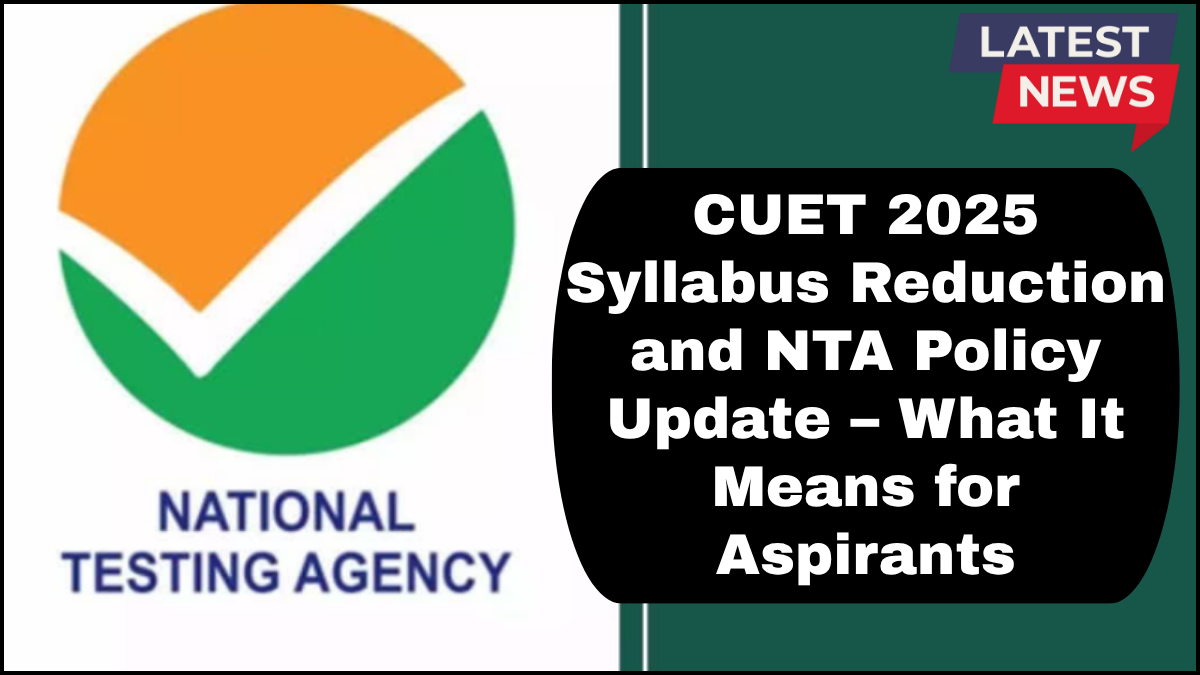The CUET 2025 syllabus reduction update and recent CUET NTA policy change announcements have sent ripples across the student community preparing for one of the most competitive entrance exams in India. With thousands vying for admission to top central universities, understanding these updates is critical for aspirants aiming to secure a seat in prestigious programs.

Here’s a detailed breakdown of what’s changing, why it matters, and how students should recalibrate their strategies in response.
What Has Changed in CUET 2025?
The National Testing Agency (NTA) has officially revised the CUET syllabus for 2025, announcing a strategic reduction in content across multiple subjects. This syllabus trim aligns with the modifications in the NCERT curriculum for Classes 11 and 12, as well as broader educational reforms under the New Education Policy (NEP).
Key highlights of the CUET 2025 syllabus reduction update:
-
Subjects like Physics, Chemistry, History, and Political Science have seen entire units removed or merged.
-
Redundant or overlapping content with school board syllabi has been streamlined.
-
The reduction focuses more on conceptual understanding rather than rote memorization.
This move is designed to make the exam more accessible and fair, especially considering the uneven academic conditions post-pandemic and the growing diversity in student educational backgrounds.
NTA’s Policy Overhaul: More Than Just Syllabus Changes
In addition to syllabus revisions, the CUET NTA policy change includes several structural and procedural updates:
-
Revised Exam Format: The paper will now place a stronger emphasis on application-based questions rather than factual recall.
-
Sectional Time Management: Time slots have been better optimized for domain-specific sections, easing pressure on students during the exam.
-
Normalization Policy Clarification: The NTA has updated how scores will be normalized across multiple shifts, aiming for more transparency and fairness.
-
Expansion of Test Centers: In a bid to improve accessibility, new exam centers are being added in Tier 2 and Tier 3 cities.
These changes reflect NTA’s intent to level the playing field and focus on academic depth over surface-level performance.
Why This Matters for Aspirants
For students aiming to crack CUET 2025, these updates can be both an opportunity and a challenge. On one hand, the reduced syllabus lightens the study load, allowing aspirants to focus on mastering core topics. On the other, the policy changes demand a shift in preparation tactics.
Implications of the CUET 2025 syllabus reduction update:
-
Streamlined Study Plans: Students can now focus on fewer chapters with deeper comprehension.
-
Improved Time Allocation: With non-essential content removed, students can dedicate more time to mock tests and previous year papers.
-
Alignment with School Boards: The overlap between board and CUET preparation is now more efficient, reducing redundancy.
How to Adapt Your Preparation Strategy
If you’re preparing for CUET 2025, here are some actionable tips to align with the new changes:
-
Start with the Official Syllabus: Download the revised syllabus directly from the NTA website. Make sure your resources match it exactly.
-
Prioritize Core Concepts: Focus on conceptual clarity and problem-solving rather than rote learning.
-
Practice Smart: Use updated mock tests and section-specific practice to get used to the revised format and timing.
-
Stay Updated: Keep a close watch on NTA bulletins and university-specific eligibility criteria, as cutoffs and requirements may shift based on the new format.
What Educators and Institutions Are Saying
Many educators have welcomed the changes, citing the shift as a necessary evolution in the Indian entrance exam ecosystem. Several coaching institutes are already updating their modules to align with the new structure. Universities, too, are adjusting their admission metrics, understanding that the updated CUET better reflects a student’s academic potential.
Final Thoughts
The CUET 2025 syllabus reduction update and the broader CUET NTA policy change are not just administrative shifts—they represent a transformation in how student potential is assessed. By focusing on understanding rather than memorization, and making exams more accessible, these changes could mark a positive turning point in higher education entry in India.
For aspirants, success in CUET 2025 will come down to how quickly and effectively they adapt. The path ahead may be leaner, but it will demand sharper focus and smarter effort.
FAQs on CUET 2025 Syllabus and NTA Policy Update
Q1: Why has the CUET 2025 syllabus been reduced?
The reduction aligns with NCERT’s trimmed syllabus and NEP goals. It aims to reduce academic burden and focus on essential, concept-based learning.
Q2: Which subjects have seen the most changes?
Subjects like History, Physics, Chemistry, and Political Science have experienced significant cuts, mainly removing repetitive or less relevant chapters.
Q3: Will the exam become easier because of the reduced syllabus?
Not necessarily. While there’s less to study, the focus is now on deeper understanding and application of knowledge, which can be more challenging.
Q4: How does the normalization policy affect CUET 2025?
The updated normalization policy ensures fairness in scoring across different shifts and exam sessions, especially useful for students writing domain tests on different days.
Q5: Should I change my coaching material?
Yes, ensure your study material reflects the revised syllabus and exam pattern. Outdated content can waste your time and mislead your preparation.
click here to learn more